Higher-Order Uniformly Convergent Numerical Scheme for Singularly Perturbed Differential Difference Equations with Mixed Small Shifts
Abstract
This paper deals with numerical treatment of singularly perturbed differential difference equations involving mixed small shifts on the reaction terms. The highest-order derivative term in the equation is multiplied by a small perturbation parameter ε taking arbitrary values in the interval (0,1]. For small values of ε, the solution of the problem exhibits exponential boundary layer on the left or right side of the domain and the derivatives of the solution behave boundlessly large. The terms having the shifts are treated using Taylor’s series approximation. The resulting singularly perturbed boundary value problem is solved using exponentially fitted operator FDM. Uniform stability of the scheme is investigated and analysed using comparison principle and solution bound. The formulated scheme converges uniformly with linear order before Richardson extrapolation and quadratic order after Richardson extrapolation. The theoretical analysis of the scheme is validated using numerical test examples for different values of ε and mesh number N.
1. Introduction
Differential equations play a prominent role in many disciplines including engineering, physics, economics, and biology. Currently different authors are working on analytical and numerical solutions of differential equations using different techniques [1, 2]. Differential difference equations (DDEs) are differential equations where the evolution of the system not only depends on the present state of the system but also depends on the past history. Singularly perturbed differential difference equations are differential equations in which the highest-order derivative term is multiplied by a small perturbation parameter ε and involves at least one term with delay. In general, when the perturbation parameter tends to zero, the smoothness of the solution of the singularly perturbed differential difference equations (SPDDEs) deteriorates and it forms boundary layer [3]. Such type of equations has applications in the study of variational problems in control theory [4] and in modelling of neuronal variability [5].
The presence of singular perturbation parameter ε in the equation leads to oscillation in the computed solution, while using standard numerical methods like FDM, FEM, and spline method [6]. To avoid this oscillation, an unacceptably large number of mesh points are required when ε is very small. This is not practical and leads to round-off error. So, to overcome the drawbacks associated with standard numerical methods, different authors have developed schemes that converge uniformly.
Numerical treatments of a class of SPDDEs have received a great deal of attention recently because of their wide applications. It is of theoretical and practical interest to consider numerical methods for such problems. Owing to this, here we present some prior studies on numerical solution of the considered problem. Lange and Miura in [7–10] studied a class of second-order DDEs in which the second derivative term is multiplied by a small parameter. The authors extend the method of matched asymptotic expansions initially developed for solving boundary value problems to obtain approximate solution for SPDDEs. In a series of papers [11–14], Kadalbajoo and Sharma developed uniformly convergent numerical methods using fitted mesh FDMs techniques. Swamy et al. [15–17] considered the problem and developed a numerical scheme using fitted operator finite difference techniques. Melesse et al. [18] applied initial value technique for treating the considered SPDDEs. Ranjan and Prasad [19] used modified fitted operator FDM for solving the problem. Sirisha et al. [20] developed fitted operator finite difference scheme using the procedure of domain decomposition. A number of authors have developed numerical scheme using exponentially fitted method for solving SPDDEs. To the authors’ knowledge, none of them show the uniform convergence of their schemes. This motivates to treat the considered SPDDEs and formulate the uniform convergence analysis of the scheme. Our contribution in this paper is to develop higher-order uniformly convergent numerical scheme using exponentially fitted FDM and to analyse the uniform convergence of the proposed scheme.
Notation 1. The symbol C is used to denote positive constant independent of ε and N. The norm ‖.‖ denotes the maximum norm.
2. Statement of the Problem
The solution of the problem in (5)-(6) exhibits regular boundary layer of thickness O(cε) and the position of the boundary layer depends on the sign of p(x). If p(x) < 0, left boundary layer exists and, for p(x) > 0, right boundary layer exists. If p(x), x ∈ [0,1] changes sign interior layer will occur [22].
It is a first-order initial value problem; for small values of cε, the solution of (5)-(6) is very close to the solution of (8) or (9).
2.1. Properties of the Analytical Solution
Lemma 1 (The maximum principle). Let z be a sufficiently smooth function defined on Ω, which satisfies z(0) ≥ 0 and z(1) ≥ 0. Then Lz(x) > 0, ∀ x ∈ Ω, implies that .
Proof. Let be such that and suppose that z(x∗) < 0. It is clear that x∗ ∉ {0,1}. Since form extrema values in calculus we have z′(x∗) = 0 and z″(x∗) ≥ 0 giving that Lz(x∗) < 0, which is contradiction to the assumption made above: Lz(x∗) > 0, ∀ x ∈ Ω. Therefore, z(x) ≥ 0, ∀ x ∈ Ω.
Lemma 2 (Stability estimate). Let u be the solution of (5)-(6); then, it satisfies the bound
Proof. Let us define barrier functions ϑ±(x) as ϑ±(x) = (‖f‖/q∗) + max{ϕ(0), ψ(1)} ± u(x) and apply the maximum principle to obtain the required bound.
On the boundary points, we have
On the differential operator,
Lemma 3. The derivatives of the solutions of (5)-(6) satisfy the bound
Proof. See [23].
3. Numerical Scheme
To get small truncation error in boundary layer region, we apply exponentially fitted operator finite difference method (FOFDM). For developing the FOFDM, we use the theory developed in asymptotic method for treating singularly perturbed BVPs. Let us consider and treat the left and the right boundary layer cases separately.
3.1. Left Boundary Layer Problems
3.2. Right Boundary Layer Problems
3.3. Convergence Analysis
In this section, we show the stability and convergence analysis for the right boundary layer problems. In similar manner, it is proved for the left boundary layer case. First, we need to prove the discrete comparison principle for the scheme in (35) for guaranteeing existence of unique discrete solution.
Lemma 4 (Discrete comparison principle). Assume that, for mesh function Ui there exists a comparison function Vi such that and if U0 ≤ V0 and UN ≤ VN, then Ui ≤ Vi, ∀ i, i = 0,1,2, …, N.
Proof. The matrix associated with operator is of size (N + 1) × (N + 1) and satisfies the property of M-matrix. See the detailed proof in [23].
This lemma gives guarantee for the existence of unique discrete solution. In the next lemma, we discuss the uniform stability of the discrete solution.
Lemma 5 (Discrete stability estimate). The solution Ui of the discrete scheme in (35) satisfies the following bound:
Proof. Let and define barrier functions by .
On the boundary points, we obtain
On the discretized spatial domain xi, 1 < i < N − 1, we obtain
By the discrete comparison principle in Lemma 4, we obtain . Hence, the required bound is satisfied.
Now, let us denote the right shifted, centred, and left shifted finite differences, respectively, as
Using Taylor’s series approximation, we obtain the bound
Now, for ρ > 0, C1 and C2 are constants, and we have |ρ coth(ρ) − 1| ≤ C1ρ2, for ρ ≤ 1. For ρ⟶∞, since limρ⟶∞coth(ρ) = 1, |ρ coth(ρ) − 1| ≤ C1ρ is given. In general, for all ρ > 0, we write
The following theorem gives truncation error bound of the proposed scheme.
Theorem 1. Let u(xi) and Ui be solutions of (5)-(6) and (35), respectively. Then the following error estimate holds:
Proof. Consider the truncation error that is given by
Using the bounds in (44), (41), and (42) gives
Substituting the bounds for the derivatives of the solution in Lemma 3, we obtain
Since , we obtain
Lemma 6. For cε⟶0, and for given fixed N, we obtain
Theorem 2. Under the hypothesis of boundedness of discrete solution, the solution of the discrete schemes in (30) satisfies the following uniform error bound:
3.4. Richardson Extrapolation
4. Examples and Numerical Results
In this section, we consider numerical examples to illustrate the theoretical findings of the developed schemes.
Example 1. Consider the problem
Example 2. Consider the problem
Example 3. Consider the problem
Example 4. Consider the problem
The exact solution of the constant coefficient interval value problem
The exact solutions of the variable coefficient problems are not known. So, we use the procedure of the double mesh technique to calculate maximum absolute error. The maximum absolute error is defined as
The rate of convergence of the scheme is given by
In Tables 1–8, the maximum absolute error of Examples 1–4 using the proposed scheme is given. In Tables 1, 3, 5, and 7, the maximum absolute error before the Richardson extrapolation is given, and in Tables 2, 4, 6, and 8, the maximum absolute error after the Richardson extrapolation is given. As one observes in the tables, for each number of mesh interval N as ε⟶0, the maximum absolute error becomes stable and uniform. This indicates that the proposed scheme convergence is independent of the perturbation parameter ε. In the last two rows of each table, we observe the ε-uniform error and the ε-uniform rate of convergence of the scheme. The scheme before the extrapolation gives first-order uniform convergence and the extrapolated scheme gives second-order uniform convergence. In Tables 9 and 10, we compare the maximum absolute error of the proposed scheme with recently published papers in [14, 15, 19]. As one observes, the proposed scheme gives more accurate result.
In Figure 1, the influence of the delay parameter on the behaviour of the solution of Examples 3 and 4 is shown for ε = 2−3 and δ = 0.1ε, 0.5ε, and 0.9ε. From Figure 2, we observe the numerical solution of Examples 1–4 for different values of the perturbation parameter ε = 2−5, 2−6, and 2−7. As observed in the figures, for ε going small, strong boundary layer is created.
| ε↓ | N⟶8 | 16 | 32 | 64 | 128 | 256 |
|---|---|---|---|---|---|---|
| 20 | 1.3808e − 03 | 3.4045e − 04 | 8.4818e − 05 | 2.1193e − 05 | 5.2970e − 06 | 1.3242e − 06 |
| 2−4 | 1.7200e − 02 | 5.0151e − 03 | 1.4739e − 03 | 3.5993e − 04 | 9.0018e − 05 | 2.2464e − 05 |
| 2−8 | 4.1828e − 02 | 2.6301e − 02 | 1.4357e − 02 | 6.0620e − 03 | 1.8873e − 03 | 5.0407e − 04 |
| 2−12 | 4.1711e − 02 | 2.6194e − 02 | 1.4838e − 02 | 7.9779e − 03 | 4.1434e − 03 | 2.1118e − 03 |
| 2−16 | 4.1704e − 02 | 2.6186e − 02 | 1.4834e − 02 | 7.9750e − 03 | 4.1418e − 03 | 2.1124e − 03 |
| 2−20 | 4.1703e − 02 | 2.6186e − 02 | 1.4833e − 02 | 7.9748e − 03 | 4.1417e − 03 | 2.1123e − 03 |
| 2−24 | 4.1703e − 02 | 2.6186e − 02 | 1.4833e − 02 | 7.9748e − 03 | 4.1417e − 03 | 2.1123e − 03 |
| 2−28 | 4.1703e − 02 | 2.6186e − 02 | 1.4833e − 02 | 7.9748e − 03 | 4.1417e − 03 | 2.1123e − 03 |
| 2−32 | 4.1703e − 02 | 2.6186e − 02 | 1.4833e − 02 | 7.9748e − 03 | 4.1417e − 03 | 2.1123e − 03 |
| 2−36 | 4.1703e − 02 | 2.6186e − 02 | 1.4833e − 02 | 7.9748e − 03 | 4.1417e − 03 | 2.1123e − 03 |
| 2−40 | 4.1703e − 02 | 2.6186e − 02 | 1.4833e − 02 | 7.9748e − 03 | 4.1417e − 03 | 2.1123e − 03 |
| EN | 4.1703e − 02 | 2.6186e − 02 | 1.4833e − 02 | 7.9748e − 03 | 4.1417e − 03 | 2.1123e − 03 |
| RN | 0.6714 | 0.8200 | 0.8953 | 0.9452 | 0.9714 | – |
| ε↓ | N⟶8 | 16 | 32 | 64 | 128 | 256 |
|---|---|---|---|---|---|---|
| 20 | 3.4045e − 04 | 2.1193e − 05 | 1.3242e − 06 | 8.2744e − 08 | 5.3296e − 09 | 1.3016e − 09 |
| 2−4 | 5.0151e − 03 | 3.5993e − 04 | 2.2464e − 05 | 1.4036e − 06 | 8.7720e − 08 | 2.2310e − 08 |
| 2−8 | 2.6301e − 02 | 6.0620e − 03 | 5.0407e − 04 | 3.3479e − 05 | 2.0797e − 06 | 4.2147e − 07 |
| 2−12 | 2.6194e − 02 | 7.9779e − 03 | 2.1118e − 03 | 4.0826e − 04 | 3.2897e − 05 | 5.2346e − 06 |
| 2−16 | 2.6186e − 02 | 7.9750e − 03 | 2.1124e − 03 | 5.3615e − 04 | 1.3446e − 04 | 3.2541e − 05 |
| 2−20 | 2.6186e − 02 | 7.9748e − 03 | 2.1123e − 03 | 5.3614e − 04 | 1.3446e − 04 | 3.2541e − 05 |
| 2−24 | 2.6186e − 02 | 7.9748e − 03 | 2.1123e − 03 | 5.3614e − 04 | 1.3446e − 04 | 3.2541e − 05 |
| 2−28 | 2.6186e − 02 | 7.9748e − 03 | 2.1123e − 03 | 5.3614e − 04 | 1.3446e − 04 | 3.2541e − 05 |
| 2−32 | 2.6186e − 02 | 7.9748e − 03 | 2.1123e − 03 | 5.3614e − 04 | 1.3446e − 04 | 3.2541e − 05 |
| 2−36 | 2.6186e − 02 | 7.9748e − 03 | 2.1123e − 03 | 5.3614e − 04 | 1.3446e − 04 | 3.2541e − 05 |
| 2−40 | 2.6186e − 02 | 7.9748e − 03 | 2.1123e − 03 | 5.3614e − 04 | 1.3446e − 04 | 3.2541e − 05 |
| EN | 2.6186e − 02 | 7.9748e − 03 | 2.1123e − 03 | 5.3614e − 04 | 1.3446e − 04 | 3.2541e − 05 |
| RN | 1.7153 | 1.9166 | 1.9781 | 1.9954 | 2.0468 | – |
| ε↓ | N⟶8 | 16 | 32 | 64 | 128 | 256 |
|---|---|---|---|---|---|---|
| 20 | 3.4492e − 03 | 1.6925e − 03 | 8.3747e − 04 | 4.1601e − 04 | 2.0724e − 04 | 1.0343e − 04 |
| 2−4 | 2.2763e − 02 | 7.6376e − 03 | 1.4739e − 03 | 1.5941e − 03 | 7.8163e − 04 | 3.8784e − 04 |
| 2−8 | 2.3670e − 02 | 1.1054e − 02 | 5.2737e − 03 | 2.5716e − 03 | 1.2314e − 03 | 4.9403e − 04 |
| 2−12 | 2.3670e − 02 | 1.1054e − 02 | 5.2735e − 03 | 2.5654e − 03 | 1.2638e − 03 | 6.2704e − 04 |
| 2−16 | 2.3670e − 02 | 1.1054e − 02 | 5.2735e − 03 | 2.5654e − 03 | 1.2638e − 03 | 6.2704e − 04 |
| 2−20 | 2.3670e − 02 | 1.1054e − 02 | 5.2735e − 03 | 2.5654e − 03 | 1.2638e − 03 | 6.2704e − 04 |
| 2−24 | 2.3670e − 02 | 1.1054e − 02 | 5.2735e − 03 | 2.5654e − 03 | 1.2638e − 03 | 6.2704e − 04 |
| 2−28 | 2.3670e − 02 | 1.1054e − 02 | 5.2735e − 03 | 2.5654e − 03 | 1.2638e − 03 | 6.2704e − 04 |
| 2−32 | 2.3670e − 02 | 1.1054e − 02 | 5.2735e − 03 | 2.5654e − 03 | 1.2638e − 03 | 6.2704e − 04 |
| 2−36 | 2.3670e − 02 | 1.1054e − 02 | 5.2735e − 03 | 2.5654e − 03 | 1.2638e − 03 | 6.2704e − 04 |
| 2−40 | 2.3670e − 02 | 1.1054e − 02 | 5.2735e − 03 | 2.5654e − 03 | 1.2638e − 03 | 6.2704e − 04 |
| EN | 2.3670e − 02 | 1.1054e − 02 | 5.2735e − 03 | 2.5654e − 03 | 1.2638e − 03 | 6.2704e − 04 |
| RN | 1.0985 | 1.0677 | 1.0396 | 1.0214 | 1.0111 | – |
| ε↓ | N⟶8 | 16 | 32 | 64 | 128 | 256 |
|---|---|---|---|---|---|---|
| 20 | 1.6925e − 03 | 4.1601e − 04 | 1.0343e − 04 | 2.5819e − 05 | 6.4524e − 06 | 1.1321e − 06 |
| 2−4 | 7.6376e − 03 | 1.5941e − 03 | 3.8784e − 04 | 9.6460e − 05 | 2.4085e − 05 | 7.6001e − 06 |
| 2−8 | 1.1054e − 02 | 2.5716e − 03 | 4.9403e − 04 | 1.0586e − 04 | 2.6498e − 05 | 8.0231e − 06 |
| 2−12 | 1.1054e − 02 | 2.5654e − 03 | 6.2704e − 04 | 1.5625e − 04 | 3.0982e − 05 | 8.2543e − 06 |
| 2−16 | 1.1054e − 02 | 2.5654e − 03 | 6.2704e − 04 | 1.5584e − 04 | 3.8901e − 05 | 9.2541e − 06 |
| 2−20 | 1.1054e − 02 | 2.5654e − 03 | 6.2704e − 04 | 1.5584e − 04 | 3.8901e − 05 | 9.2541e − 06 |
| 2−24 | 1.1054e − 02 | 2.5654e − 03 | 6.2704e − 04 | 1.5584e − 04 | 3.8901e − 05 | 9.2541e − 06 |
| 2−28 | 1.1054e − 02 | 2.5654e − 03 | 6.2704e − 04 | 1.5584e − 04 | 3.8901e − 05 | 9.2541e − 06 |
| 2−32 | 1.1054e − 02 | 2.5654e − 03 | 6.2704e − 04 | 1.5584e − 04 | 3.8901e − 05 | 9.2541e − 06 |
| 2−36 | 1.1054e − 02 | 2.5654e − 03 | 6.2704e − 04 | 1.5584e − 04 | 3.8901e − 05 | 9.2541e − 06 |
| 2−40 | 1.1054e − 02 | 2.5654e − 03 | 6.2704e − 04 | 1.5584e − 04 | 3.8901e − 05 | 9.2541e − 06 |
| EN | 1.1054e − 02 | 2.5654e − 03 | 6.2704e − 04 | 1.5584e − 04 | 3.8901e − 05 | 9.2541e − 06 |
| RN | 2.1073 | 2.0326 | 2.0085 | 2.0022 | 2.0716 | – |
| ε↓ | N⟶8 | 16 | 32 | 64 | 128 | 256 |
|---|---|---|---|---|---|---|
| 20 | 1.1318e − 03 | 2.7968e − 04 | 6.9551e − 05 | 1.7366e − 05 | 4.3405e − 06 | 1.0850e − 06 |
| 2−4 | 1.4786e − 02 | 3.6872e − 03 | 8.5968e − 04 | 2.1118e − 04 | 5.2578e − 05 | 1.3152e − 05 |
| 2−8 | 4.7613e − 02 | 2.9531e − 02 | 1.4879e − 02 | 5.5516e − 03 | 1.4704e − 03 | 3.3684e − 04 |
| 2−12 | 4.8375e − 02 | 3.0553e − 02 | 1.7528e − 02 | 9.4597e − 03 | 4.9243e − 03 | 2.4698e − 03 |
| 2−16 | 4.8423e − 02 | 3.0586e − 02 | 1.7549e − 02 | 9.4718e − 03 | 4.9323e − 03 | 2.5185e − 03 |
| 2−20 | 4.8426e − 02 | 3.0589e − 02 | 1.7550e − 02 | 9.4725e − 03 | 4.9327e − 03 | 2.5187e − 03 |
| 2−24 | 4.8426e − 02 | 3.0589e − 02 | 1.7550e − 02 | 9.4725e − 03 | 4.9328e − 03 | 2.5187e − 03 |
| 2−28 | 4.8426e − 02 | 3.0589e − 02 | 1.7550e − 02 | 9.4725e − 03 | 4.9328e − 03 | 2.5187e − 03 |
| 2−32 | 4.8426e − 02 | 3.0589e − 02 | 1.7550e − 02 | 9.4725e − 03 | 4.9328e − 03 | 2.5187e − 03 |
| 2−36 | 4.8426e − 02 | 3.0589e − 02 | 1.7550e − 02 | 9.4725e − 03 | 4.9328e − 03 | 2.5187e − 03 |
| 2−40 | 4.8426e − 02 | 3.0589e − 02 | 1.7550e − 02 | 9.4725e − 03 | 4.9328e − 03 | 2.5187e − 03 |
| EN | 4.8426e − 02 | 3.0589e − 02 | 1.7550e − 02 | 9.4725e − 03 | 4.9328e − 03 | 2.5187e − 03 |
| RN | 0.6628 | 0.8015 | 0.8897 | 0.9413 | 0.9697 | – |
| ε↓ | N⟶8 | 16 | 32 | 64 | 128 | 256 |
|---|---|---|---|---|---|---|
| 20 | 2.7968e − 04 | 1.7366e − 05 | 1.0850e − 06 | 6.7812e − 08 | 4.2386e − 09 | 1.0101e − 09 |
| 2−4 | 3.6872e − 03 | 2.1118e − 04 | 1.3152e − 05 | 8.2173e − 07 | 5.0203e − 08 | 1.2341e − 08 |
| 2−8 | 2.9531e − 02 | 5.5516e − 03 | 3.3684e − 04 | 2.0489e − 05 | 1.2809e − 06 | 3.7125e − 07 |
| 2−12 | 3.0553e − 02 | 9.4597e − 03 | 2.4698e − 03 | 3.8494e − 04 | 2.2756e − 05 | 4.8133e − 06 |
| 2−16 | 3.0586e − 02 | 9.4718e − 03 | 2.5185e − 03 | 6.3984e − 04 | 1.5770e − 04 | 3.8042e − 05 |
| 2−20 | 3.0589e − 02 | 9.4725e − 03 | 2.5187e − 03 | 6.3989e − 04 | 1.6062e − 04 | 3.9001e − 05 |
| 2−24 | 3.0589e − 02 | 9.4725e − 03 | 2.5187e − 03 | 6.3989e − 04 | 1.6062e − 04 | 3.9001e − 05 |
| 2−28 | 3.0589e − 02 | 9.4725e − 03 | 2.5187e − 03 | 6.3989e − 04 | 1.6062e − 04 | 3.9001e − 05 |
| 2−32 | 3.0589e − 02 | 9.4725e − 03 | 2.5187e − 03 | 6.3989e − 04 | 1.6062e − 04 | 3.9001e − 05 |
| 2−36 | 3.0589e − 02 | 9.4725e − 03 | 2.5187e − 03 | 6.3989e − 04 | 1.6062e − 04 | 3.9001e − 05 |
| 2−40 | 3.0589e − 02 | 9.4725e − 03 | 2.5187e − 03 | 6.3989e − 04 | 1.6062e − 04 | 3.9001e − 05 |
| EN | 3.0589e − 02 | 9.4725e − 03 | 2.5187e − 03 | 6.3989e − 04 | 1.6062e − 04 | 3.9001e − 05 |
| RN | 1.6912 | 1.9111 | 1.9768 | 1.9942 | 2.0421 | – |
| ε↓ | N⟶8 | 16 | 32 | 64 | 128 | 256 |
|---|---|---|---|---|---|---|
| 20 | 9.0320e − 03 | 4.5788e − 03 | 2.2918e − 03 | 1.1469e − 03 | 5.7338e − 04 | 2.8666e − 04 |
| 2−4 | 3.7979e − 02 | 1.6150e − 02 | 6.1639e − 03 | 2.4525e − 03 | 1.0562e − 03 | 4.8456e − 04 |
| 2−8 | 4.3631e − 02 | 2.4943e − 02 | 1.3421e − 02 | 6.9160e − 03 | 3.1649e − 03 | 1.2055e − 03 |
| 2−12 | 4.3723e − 02 | 2.4996e − 02 | 1.3451e − 02 | 7.0011e − 03 | 3.5749e − 03 | 1.8068e − 03 |
| 2−16 | 4.3728e − 02 | 2.4999e − 02 | 1.3452e − 02 | 7.0020e − 03 | 3.5755e − 03 | 1.8071e − 03 |
| 2−20 | 4.3729e − 02 | 2.4999e − 02 | 1.3452e − 02 | 7.0021e − 03 | 3.5755e − 03 | 1.8071e − 03 |
| 2−24 | 4.3729e − 02 | 2.4999e − 02 | 1.3452e − 02 | 7.0021e − 03 | 3.5755e − 03 | 1.8071e − 03 |
| 2−28 | 4.3729e − 02 | 2.4999e − 02 | 1.3452e − 02 | 7.0021e − 03 | 3.5755e − 03 | 1.8071e − 03 |
| 2−32 | 4.3729e − 02 | 2.4999e − 02 | 1.3452e − 02 | 7.0021e − 03 | 3.5755e − 03 | 1.8071e − 03 |
| 2−36 | 4.3729e − 02 | 2.4999e − 02 | 1.3452e − 02 | 7.0021e − 03 | 3.5755e − 03 | 1.8071e − 03 |
| 2−40 | 4.3729e − 02 | 2.4999e − 02 | 1.3452e − 02 | 7.0021e − 03 | 3.5755e − 03 | 1.8071e − 03 |
| EN | 4.3729e − 02 | 2.4999e − 02 | 1.3452e − 02 | 7.0021e − 03 | 3.5755e − 03 | 1.8071e − 03 |
| RN | 0.8067 | 0.8940 | 0.9420 | 0.9696 | 0.9845 | – |
| ε↓ | N⟶8 | 16 | 32 | 64 | 128 | 256 |
|---|---|---|---|---|---|---|
| 20 | 4.5788e − 03 | 1.1469e − 03 | 2.8666e − 04 | 7.1658e − 05 | 1.7914e − 05 | 4.4784e − 06 |
| 2−4 | 1.6150e − 02 | 2.4525e − 03 | 4.8456e − 04 | 1.1290e − 04 | 2.7710e − 05 | 6.5434e − 06 |
| 2−8 | 2.4943e − 02 | 6.9160e − 03 | 1.2055e − 03 | 1.6886e − 04 | 3.2527e − 05 | 8.9632e − 06 |
| 2−12 | 2.4996e − 02 | 7.0011e − 03 | 1.8068e − 03 | 4.5088e − 04 | 7.6356e − 05 | 1.2456e − 05 |
| 2−16 | 2.4999e − 02 | 7.0020e − 03 | 1.8071e − 03 | 4.5547e − 04 | 1.1410e − 04 | 2.8541e − 05 |
| 2−20 | 2.4999e − 02 | 7.0021e − 03 | 1.8071e − 03 | 4.5548e − 04 | 1.1410e − 04 | 2.8541e − 05 |
| 2−24 | 2.4999e − 02 | 7.0021e − 03 | 1.8071e − 03 | 4.5548e − 04 | 1.1410e − 04 | 2.8541e − 05 |
| 2−28 | 2.4999e − 02 | 7.0021e − 03 | 1.8071e − 03 | 4.5548e − 04 | 1.1410e − 04 | 2.8541e − 05 |
| 2−32 | 2.4999e − 02 | 7.0021e − 03 | 1.8071e − 03 | 4.5548e − 04 | 1.1410e − 04 | 2.8541e − 05 |
| 2−36 | 2.4999e − 02 | 7.0021e − 03 | 1.8071e − 03 | 4.5548e − 04 | 1.1410e − 04 | 2.8541e − 05 |
| 2−40 | 2.4999e − 02 | 7.0021e − 03 | 1.8071e − 03 | 4.5548e − 04 | 1.1410e − 04 | 2.8541e − 05 |
| EN | 2.4999e − 02 | 7.0021e − 03 | 1.8071e − 03 | 4.5548e − 04 | 1.1410e − 04 | 2.8541e − 05 |
| RN | 1.8360 | 1.9541 | 1.9882 | 1.9971 | 1.9992 | – |
| ε↓ | N⟶8 | 16 | 32 | 64 | 128 | 256 |
|---|---|---|---|---|---|---|
| Proposed scheme | ||||||
| 10−4 | 3.0589e − 02 | 9.4725e − 03 | 2.5187e − 03 | 6.3989e − 04 | 1.6062e − 04 | 3.9001e − 05 |
| 10−5 | 3.0589e − 02 | 9.4725e − 03 | 2.5187e − 03 | 6.3989e − 04 | 1.6062e − 04 | 3.9001e − 05 |
| 10−6 | 3.0589e − 02 | 9.4725e − 03 | 2.5187e − 03 | 6.3989e − 04 | 1.6062e − 04 | 3.9001e − 05 |
| Result in [15] | ||||||
| 10−4 | 0.10207612 | 0.06281638 | 0.03556178 | 0.01906740 | 0.00989895 | 0.00504914 |
| 10−5 | 0.10210236 | 0.06283382 | 0.03557070 | 0.01907016 | 0.00989794 | 0.00504604 |
| 10−6 | 0.10210499 | 0.06283557 | 0.03557159 | 0.01907044 | 0.00989798 | 0.00504673 |
| ε↓ | N⟶10 | 100 | 10 | 100 | 10 | 100 |
|---|---|---|---|---|---|---|
| Result in [19] | Result in [14] | Proposed scheme | ||||
| 10−1 | 1.5339e − 02 | 1.9170e − 04 | 0.01596700 | 0.00017254 | 9.2052e − 03 | 5.8912e − 04 |
| 10−2 | 2.8175e − 02 | 1.8656e − 03 | 0.08016582 | 0.00199505 | 2.0378e − 02 | 1.0991e − 03 |
| 10−3 | 2.8534e − 02 | 3.3897e − 03 | 0.10168369 | 0.00999987 | 2.0543e − 02 | 2.2978e − 03 |
| 10−4 | 2.8570e − 02 | 3.3954e − 03 | 0.10406804 | 0.01230494 | 2.0554e − 02 | 2.3059e − 03 |
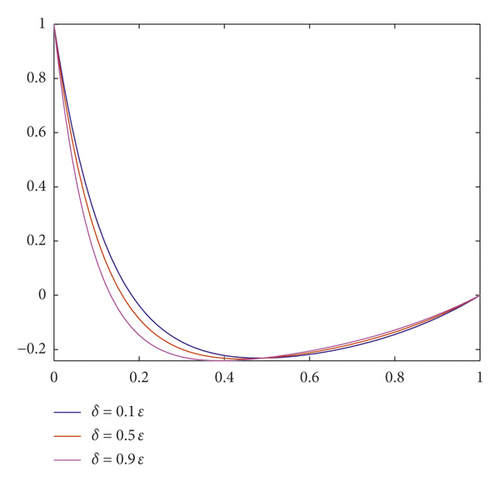
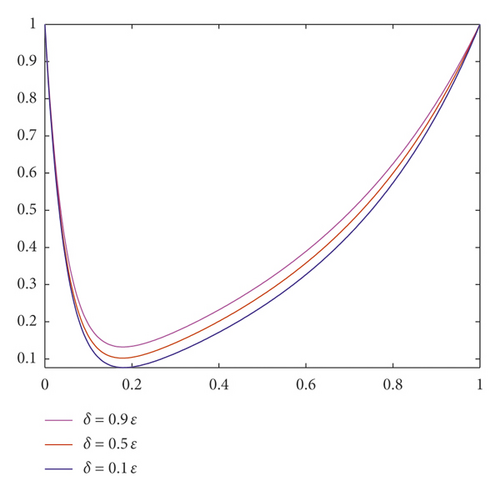
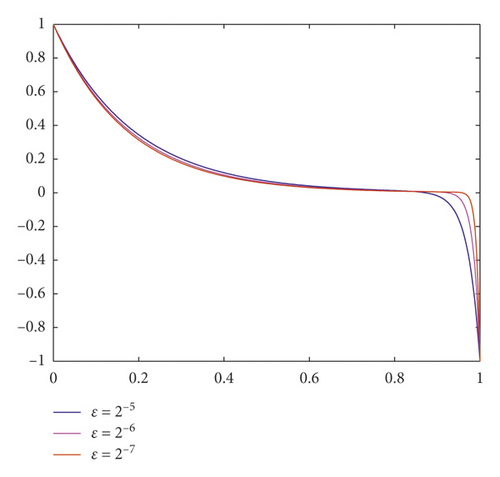
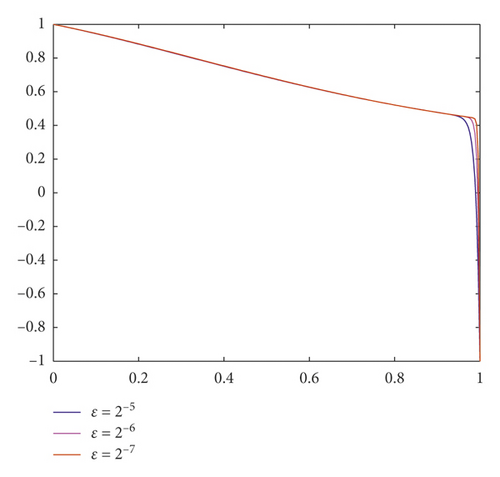
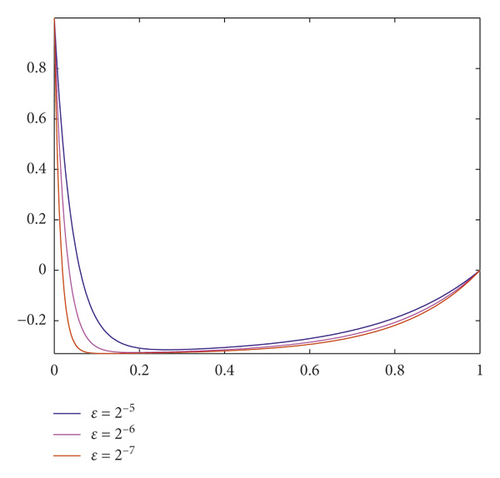

5. Conclusion
In this paper, singularly perturbed differential difference equations having mixed small shifts on reaction terms of the equation are considered. The considered problem exhibits boundary layer for small values of the perturbation parameter. The bounds and the behaviour of the continuous solution are discussed. Numerical scheme is developed using the technique of exponentially fitted finite difference method. Stability of the scheme is investigated using comparison principle and solution bound. The proposed scheme converges uniformly with rate of convergence of one before Richardson extrapolation and of two after Richardson extrapolation is applied. Test examples exhibiting boundary layers are considered to validate the theoretical finding. The finding in the computation agrees well with the theoretical findings. The proposed scheme gives more accurate results than existing research findings in the literature. In future works, we extend the proposed scheme for singularly perturbed parabolic differential difference equations and singularly perturbed problems with degenerate coefficients.
Conflicts of Interest
The authors declare no conflicts of interest.
Open Research
Data Availability
No data were used to support the study.




